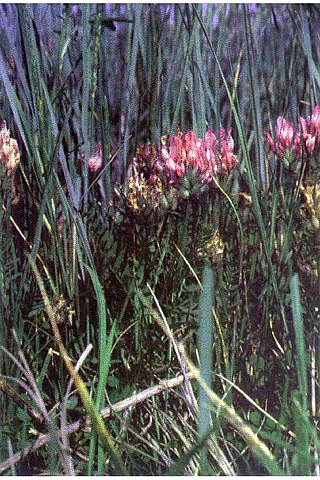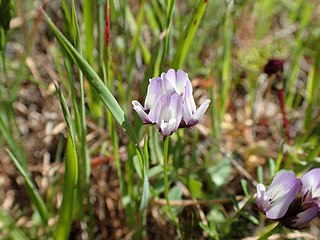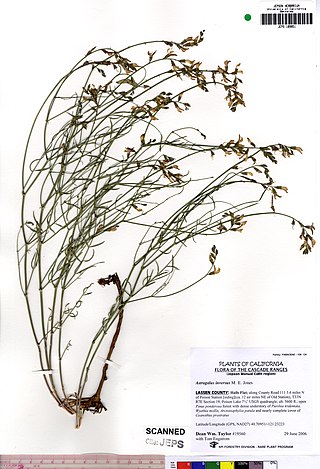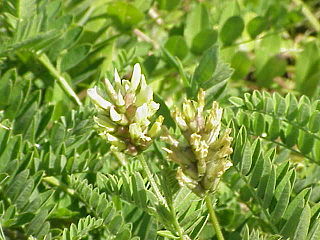
Astragalus is a large genus of over 3,000 species of herbs and small shrubs, belonging to the legume family Fabaceae and the subfamily Faboideae. It is the largest genus of plants in terms of described species. The genus is native to temperate regions of the Northern Hemisphere. Common names include milkvetch, locoweed and goat's-thorn. Some pale-flowered vetches are similar in appearance, but they are more vine-like than Astragalus.

Astragalus canadensis is a common and widespread member of the milkvetch genus in the legume family, known commonly as Canadian milkvetch. The plant is found throughout Canada and the United States in many habitats including wetlands, woodlands, and prairies.

Astragalus bisulcatus, commonly called two-grooved milkvetch or silver-leafed milkvetch, is a leafy perennial with pea-like flowers. It is native to central and western North America, and typically grows on selenium-rich soils. It accumulates selenium within its tissues, and when livestock consume it, the selenium can be toxic.

Astragalus agrestis is a species of milkvetch known by the common names purple milkvetch, purple loco, and field milkvetch. It is native to much of western and northern North America from most of Canada to the southwestern United States, as well as eastern Asia. It grows in vernally moist areas such as meadows, and is often found in sagebrush.

Astragalus bernardinus, known by the common name San Bernardino milkvetch or the Lesser Three-keeled Milkvetch, is a species of milkvetch. It is a plant of desert and dry mountain slope habitat. It is native to California.
Astragalus bicristatus is a species of milkvetch known by the common names crested milkvetch and two-crested milkvetch. It is endemic to southern California, where it grows in the coniferous forests of the San Gabriel and San Bernardino Mountains of the Transverse Ranges.

Astragalus breweri is a species of milkvetch known by the common name Brewer's milkvetch. It is endemic to northern California, where it is found in several counties surrounding the north edge of the San Francisco Bay Area. It grows in open habitat in the North Coast Ranges, sometimes on serpentine soils.

Astragalus casei is a species of milkvetch known by the common name Case's milkvetch. It is native to the Mojave Desert and its sky island woodlands of eastern California and western Nevada.

Astragalus cimae is a species of milkvetch known by the common name Cima milkvetch. It is native to the Mojave Desert and its sky island woodlands of eastern California western Nevada, especially on calcareous soils, including the Cima Dome area in the Mojave National Preserve.
Astragalus curtipes is a species of milkvetch known by the common name Morro milkvetch. It is endemic to the Central Coast of California, including the Morro Bay area in San Luis Obispo County.

Astragalus filipes is a species of milkvetch known by the common name basalt milkvetch. It is native to western North America from British Columbia to California to Utah, where it grows in many types of habitat, especially dry areas.

Astragalus inversus is a species of milkvetch known by the common name Susanville milkvetch.

Astragalus purshii is a species of milkvetch known by the common names woollypod milkvetch and Pursh's milkvetch.

Astragalus osterhoutii, or the Osterhout milkvetch or Kremmling milkvetch, is an endangered species of milkvetch, discovered and collected in 1905 at Sulfur Spring in Grand County Colorado by Colorado botanist George Everett Osterhout for which the plant was named. It is found in the U.S. state of Colorado, in a 13 kilometres (8.1 mi) radius near the town of Kremmling.

Astragalus cicer, the chickpea milkvetch, chick-pea milk-vetch or cicer milkvetch, is a perennial flowering plant native to Eastern Europe, popularized and subsequently transported to areas in Southern Europe, North America, and South America. It produces pods that resemble those of chickpeas. Its flowers are usually of pale yellow tint, and attract bumble or European honey bees for pollination. Growth often exceeds 0.6 meters, up to a height of 1 meter in length.
Astragalus hypoxylus is a rare species of flowering plant in the legume family known by the common name Huachuca milkvetch, or Huachuca Mountain milkvetch. It is endemic to Arizona in the United States, where it is known only from the Patagonia and Huachuca Mountains. There are three populations.
Astragalus flavus is a perennial plant in the legume family (Fabaceae) found in the Colorado Plateau and Canyonlands region of the southwestern United States.

Astragalus desperatus is a perennial plant in the legume family (Fabaceae) found in the Colorado Plateau and Canyonlands region of the southwestern United States.

Astragalus crassicarpus, known as ground plum or buffalo plum, is a perennial species of flowering plant in the legume family, Fabaceae, native to North America. It was described in 1813. The fruit is edible and was used by Native Americans as food and horse medicine. It is a host of afranius duskywing larvae. It is also known as groundplum milkvetch and pomme de prairie.
















